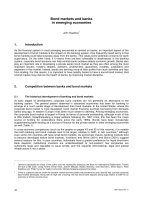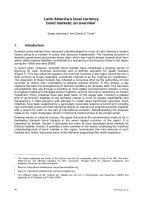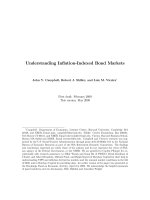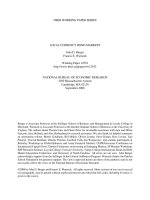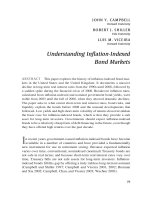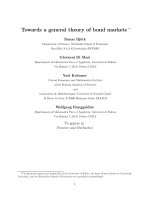LOCAL CURRENCY BOND MARKETS - NATIONAL BUREAU OF ECONOMIC RESEARCH doc
Bạn đang xem bản rút gọn của tài liệu. Xem và tải ngay bản đầy đủ của tài liệu tại đây (187.94 KB, 22 trang )
NBER WORKING PAPER SERIES
LOCAL CURRENCY BOND MARKETS
John D. Burger
Francis E. Warnock
Working Paper 12552
/>NATIONAL BUREAU OF ECONOMIC RESEARCH
1050 Massachusetts Avenue
Cambridge, MA 02138
September 2006
Burger is Associate Professor at the Sellinger School of Business and Management at Loyola College in
Maryland. Warnock is Associate Professor at the Darden Graduate School of Business at the University of
Virginia. The authors thank Thomas Jans and Denis Petre for invaluable assistance with data and Jillian
Faucette, Sara Holland, and Alex Rothenberg for research assistance. We also thank for helpful comments
an anonymous referee, Morris Goldstein, Bill Helkie, Olivier Jeanne, Steve Kamin, Ross Levine, Ugo
Panizza, Vincent Reinhart, Charles Thomas, Joachim Voth, Jon Wongswan, and seminar participants at
Berkeley Workshop on Global Balances and Asian Financial Markets, CEPR/Gerzensee Conference on
International Capital Flows, Darden Conference on Investing in Emerging Markets, IF Monday Workshop,
IMF Research Seminar, Loyola College, Towson University, Trinity College International Bond and Debt
Market Integration Conference, and University of North Carolina. All errors are our own. John Burger
acknowledges support from the Sellinger School Junior Sabbatical Program. Warnock thanks the Darden
School Foundation for generous support. The views expressed herein are those of the author(s) and do not
necessarily reflect the views of the National Bureau of Economic Research.
©2006 by John D. Burger and Francis E. Warnock. All rights reserved. Short sections of text, not to exceed
two paragraphs, may be quoted without explicit permission provided that full credit, including © notice, is
given to the source.
Local Currency Bond Markets
John D. Burger and Francis E. Warnock
NBER Working Paper No. 12552
September 2006
JEL No. F30, G15, O16
ABSTRACT
We analyze the development of 49 local bond markets. Our main finding is that policies and laws
matter: Countries with stable inflation rates and strong creditor rights have more developed local
bond markets and rely less on foreign-currency-denominated bonds. The results suggest that
“original sin” is a misnomer. Emerging economies are not inherently dependent upon
foreign-currency debt. Rather, by improving policy performance and strengthening institutions they
may develop local currency bond markets, reduce their currency mismatch, and lessen the likelihood
of future crises.
John D. Burger
Loyola College in Maryland
4501 N. Charles Street
Baltimore MD 21210-2699
Francis E. Warnock
Darden Business School
University of Virginia
Charlottesville, VA 22906-6550
and NBER
1. Introduction
The currency crisis literature has recently focused on the importance of developing
local currency bond markets in order to avoid the financial fragility associated with a
currency mismatch. Such a mismatch arises, for example, if a firm’s assets are in the local
currency but it borrows in a foreign currency. Absent a currency mismatch, a negative
shock in, for example, Brazil that caused investors to sell Brazilian assets would naturally
correct itself; the real would plummet and, in the normal course of events, the depreciation
would be expansionary and would improve Brazil’s external balances (as its products
became more competitive and foreign goods became expensive). But if Brazil had
borrowed heavily in foreign-currency-denominated debt—perhaps because it did not have a
local currency bond market—the depreciation would immediately and severely worsen
government and private balance sheets and greatly increase debt repayment burdens. Firms
would in turn reduce investment and push the country into a recession, generating pressure
for further currency depreciation. The link between this downward spiral of a currency
crisis and the initial currency mismatch has been emphasized in the theoretical and empirical
literature (Goldstein and Turner, 2004).
1
If underdeveloped local currency markets are linked to financial instability, we
should aim to determine the source of this emerging market affliction. The extant literature
does not provide an unambiguous prescription, as bond market development is at the heart
of a current debate in academic and policy circles. Eichengreen and Hausmann (1999)
describe emerging economies as suffering from “original sin,” defined as a situation in
1
See also Krugman (1999), Jeanne and Zettelmeyer (2002), Schneider and Tornell(2004), and Aghion,
Bacchetta and Banerjee (2004). The literature on currency mismatches, as well as by extension our work, also
has a link to the vast literature on dollarization. For example, Goldstein and Turner (2004) note that a currency
mismatch could ultimately force an emerging economy to dollarize.
2
which the domestic currency cannot be used to borrow abroad or to borrow long term, even
domestically. The phrase “original sin” itself suggests that emerging markets cannot
overcome this problem on their own. In support of this notion, Eichengreen, Hausmann,
and Panizza (2002), henceforth EHP, find that original sin is exogenous to conditions in
developing countries (such as rule of law and past inflation performance). In contrast, La
Porta, Lopez-de-Silanes, Shleifer, and Vishny (henceforth LLSV) (1997) find that debt
markets (bank debt plus nonfinancial bonds) are larger in countries with better rule of law
and creditor rights.
Are policymakers in emerging markets truly blameless for their fallen state, as the
EHP findings suggest, or, as the LLSV results imply, are there ways emerging markets can
improve their financial systems? This question is important in academic circles, as some
papers follow EHP’s lead and assume that original sin is exogenous.
2
But it is more than an
academic curiosum. If original sin is exogenous, as EHP suggest, international
organizations may have an important role in the relief effort.
3
In contrast, the LLSV results
imply that original sin is endogenous (and a misnomer) and that a supranational solution is
only second best; the first best solution would address the source of the problem.
We weigh in on this debate using data that are more complete than either LLSV or
EHP. Specifically, we present data on the characteristics of bond markets around the world
and analyze factors associated with local currency bond market development. Compiling
data from a number of sources, we first present information on the size and currency
2
For example, Jeanne and Zettelmeyer (2002) start from a situation of original sin and examine solutions that
involve international lending
3
For the particular global solution proposed by EHP, see the November 22, 2002 Financial Times op-ed by
Eichengreen and Hausmann, “How to Eliminate Original Financial Sin.”
3
composition of bond markets in 49 countries. We then analyze factors associated with local
bond market development.
Our analysis reveals roles for both creditor-friendly policies and creditor-friendly
laws. Countries with better historical inflation performance (an outcome of creditor-friendly
policies) have more developed local bond markets, both private and government, and rely
less on foreign-currency-denominated bonds. Creditor-friendly laws matter, too; strong rule
of law is associated with deeper local bond markets, while countries with better creditor
rights are able to issue a higher share of bonds in their local currency.
We also show that the necessary conditions for bond market development are very
similar to those that foster development of the banking system. Countries in which people
are not willing to become creditors—at one extreme this is an unwillingness to deposit
money in banks—will have undeveloped banking systems and underdeveloped bond
markets. This has implications for the literature on financial development and growth [see,
for example, Levine (2002) and Beck and Levine (2004)]; when that literature brings bonds
into the analysis, the debate may well shift from the relative merits of bank-based and
(equity) market-based financial systems to debt (i.e., banking and bonds) versus equity.
2. Bond Markets Around the World
Unlike equity markets, about which information is readily available, comprehensive
information on the size of the global bond market is not available from any one source.
LLSV (1997) present data on debt finance, but their measure is of private bank debt and
4
nonfinancial bonds. In this section we present information on the size and currency
composition of bond markets in 49 countries.
4
Our estimates of the size of each country’s bond market are derived primarily from
unpublished data from the Bank for International Settlements (BIS). For international
bonds (i.e., those in foreign currencies or placed abroad), we use the security-level data
underlying BIS Quarterly Review Table 14B. To form the security-level international bonds
database, the BIS combines information from Capital DATA (Bondware), Thomson
Financial Securities Data (Platinum), and Euroclear; identifies and removes duplicates;
corrects mistakes; ensures a consistent classification of issuers across the different sources;
and performs general quality control. The BIS data on international bonds are likely the
most comprehensive available, but they do not include information on Brady bonds, which
we obtain from Merrill Lynch (2002). For domestic bonds, we rely again on unpublished
data from the BIS, but here we must augment BIS data with data retrieved from Bloomberg.
BIS Quarterly Review Table 16A publishes data on outstanding domestic debt securities, but
combines both short- and long-term securities. In our study we focus on long-term debt
securities—those with an original maturity of more than one year—and so utilize instead the
unpublished long-term component of the domestic debt data. Augmentation is necessary,
because for seven countries in our study—Brazil, India, Ireland, New Zealand, Poland,
Russia, and Turkey—BIS data indicate no domestic long-term debt issued by private
entities. However, a Bloomberg search uncovered private bonds outstanding as of end-2001
for all but Turkey; amounts, which are not large, were added to our data after a cross-check
4
Another source of information on the size of bond markets across countries had been Merrill Lynch’s Size &
Structure of the World Bond Market, but it was recently discontinued. Other recent discussions of bond
market development include IMF (2002) and Mihaljek, Scatigna, and Villar (2002).
5
that ensured the bonds were not placed abroad (which would be double counting because
such bonds are in our international debt data).
The global bond market totaled $31.2 trillion in 2001 (Table 1). The bulk of
outstanding bonds were issued by developed countries (93%), in particular the United States
(46%), euro area (22%), and Japan (16%). Emerging market issuance comprised the other
7% of the global bond market, with issuance much greater in emerging Asia (3.6% of the
global market) than in Latin America (1.9%). Developed country bond markets not only
comprised a large portion of the global bond market, but they were also large relative to the
size of their economies: most developed countries have outstanding bonds that are about
equal in magnitude to the size of annual GDP (third column). For example, the bonds-to-
GDP ratio is 105% for Germany, 116% in Japan, and 141% in the United States. Bond
markets in developing countries are much smaller, averaging just 38% of annual GDP.
<<Table 1 here>>
Table 1 also provides data on the extent of local currency bond market development
in 49 countries. Local currency bonds are those issued by residents of a particular country
(for example, Chile) in that country’s currency (Chilean pesos), regardless of whether it was
placed in the domestic market or offshore. Local currency bond markets make up the bulk
of the global bond market (right panel of Table 1), totaling $28.7 trillion, or 92% of all
bonds; the other 8% of outstanding bonds were issued in foreign currencies, primarily the
dollar, euro, and sterling.
Previous studies focused on international bonds (EHP) or bank debt and non-
financial bonds (LLSV). Our more complete bond market data—which includes both
private and public issuance placed both at home and abroad—allow a more comprehensive
6
study of bond market development. To illustrate some nuances revealed by the data, Table
2 provides a comparison of bond market development in Argentina, Chile, and the UK.
EHP focus on the currency composition of a country’s external bonds (i.e., bonds placed in
external markets); the second column displays (one minus) an EHP measure of original sin,
namely the fraction of each country’s external bonds that is denominated in local currency.
An expanded measure would also include information on the domestic bond market; column
4 shows the local currency share once domestic bond markets are included. Note that
focusing strictly on external bonds would ignore the fact that Chile has a more extensive
domestic bond market than Argentina. Even this expanded currency share measure can be a
bit deceiving, as it places Chile and the UK on equal footing. More informative than the
local currency share of a country’s bond market is the actual development of the local
currency bond market, which we display in the final column, as the size of a nation’s local-
currency-denominated bond market divided by GDP. We believe this last measure gets to
the heart of the issue: It takes a sizeable local currency bond market to be free from original
sin.
<<Table 2 here>>
3. The Determinants of Local Bond Market Development
In this section we present our primary regression results, address concerns about
endogeneity, and discuss the similarities of factors that are associated with the development
of banking systems and bond markets.
3.1 Primary Regression Results
7
In Table 3, we examine the determinants of two general measures of local bond
market development: the ratio of the size of the local bond market to GDP (Local Bond
Market Development) and the share of a country’s outstanding bonds that are denominated
in the local currency (Local Currency Share). To ascertain whether private and government
bond markets differ materially, we will also (in Table 4) separate our Local Bond Market
Development variable into its private and government components. In both tables, we
examine the influence of Rule of Law, Creditor Rights, fiscal balance (calculated as a
percent of GDP and averaged over a 20-year period), country size (as measured by the log
of GDP in 2001), and growth rates (annual GDP growth over the preceding ten years).
5
Creditor Rights measures whether the laws of a country are creditor friendly; we also
include another variable, Inflation Variance (the variance of the inflation rate over the past
ten years), as a measure of whether policies have been creditor- friendly. In both tables,
odd-numbered columns present results from parsimonious regressions of 49 countries (42
countries in Table 4); even-numbered columns include other variables that have less
coverage and reduce the sample to 41 countries (37 countries in Table 4).
6
<<Table 3 here>>
All regressions in Table 3 provide strong evidence that countries with better inflation
performance (the result, perhaps, of more stable monetary and fiscal policies) have larger
local currency bond markets and rely less on foreign-currency bonds. The robustness of the
5
The Rule of Law variable is, as reported in LLSV (1997), an average over 1982-1995 of the International
Country Risk Guide assessment of law and order tradition. We supplement this source with 2000 data from
Gwartney et al. (2003) for five other countries: China, Czech Republic, Hungary, Poland, and Iceland.
Creditor Rights, also from LLSV (1997), aggregates the various rights that secured creditors have in
liquidation and reorganization. Fiscal balance data are from the World Bank's World Development Indicators
database, with data from Hong Kong and Taiwan obtained from OECD data and the IMF's International
Financial Statistics.
6
In even-numbered columns we lose one country that does not have ten years of historical GDP (Czech
Republic) and seven that do not have data on Creditor Rights (China, Hungary, Iceland, Luxembourg,
Morocco, Poland, and Venezuela).
8
inflation result is supported by two additional tests: Excluding outliers by omitting the four
countries with greatest inflation variance, or replacing inflation variance with the mean of
inflation, does not materially impact the results reported in Table 3.
7
In addition to the role
of inflation, our results suggest countries with stronger institutions (high score on Rule of
Law) have broader local currency bond markets, and those with stronger Creditor Rights
rely less on foreign-currency bonds. The importance of institutional and policy settings
suggest that even emerging economies have the ability to develop local currency bond
markets. Emerging market economies are not predestined to suffer from original sin.
More specifically, our results suggest that countries such as Australia (with a low
score on creditor rights), Indonesia (poor inflation performance), or Peru (poor rule of law)
might increase the breadth of their local currency bond market and rely less on foreign
currency borrowing if they address their deficient creditor laws and policies. To gauge the
importance of various factors, our estimates in column (1) imply that (ceteris paribus) if
Brazil had Denmark’s rule of law, its bond market as a share of GDP would be 43
percentage points higher. If Brazil had Denmark’s inflation history, its bond market would
be 42 percentage points (of GDP) larger. These amounts are both economically
significant—Brazil’s local currency bond market is currently only 22 percent of GDP—and
suggest an important role for creditor-friendly policies in emerging markets.
In Table 4 we separately analyze the government and private bonds markets. The
results suggest that the determinants of the size of government and private bond markets are
quite similar: Countries with better inflation performance and stronger rule of law have
larger sovereign and corporate bond markets. The main difference is the influence of fiscal
7
Tables with these robustness checks are available from the authors upon request.
9
policy. Not surprisingly, a tendency to run fiscal deficits is associated with larger
government bond markets, where much of the deficit financing occurs.
<<Table 4 here>>
Our results are consistent with the model of Jeanne (2003), which shows an
important role for monetary policy credibility in explaining the currency composition of a
country’s debt. Our results are also largely consistent with those of LLSV, but contrast
sharply with those of EHP, who find that the only determinant of bond market development
is country size.
8
The most likely reason that our results contrast with EHP is because their
study includes only bonds that were initially placed abroad or denominated in a foreign
currency. As we demonstrated in Section 2, focusing only on so-called international bonds
results in vastly different country rankings.
3.2 Addressing Endogeneity Concerns
We take seriously the notion that inflation could plausibly be considered
endogenous. For example, there may be virtuous interactions between the development of
the bond market and future inflation performance. Eichengreen and Hausmann (1999)
suggest that a well-developed domestic bond market may generate a political constituency
opposed to inflationary policies.
We address concerns about endogeneity in two ways. First, we note that in our
regressions, inflation is already lagged; we examine the influence of inflation over a ten-
year period on the subsequent size of the bond market. If we lag inflation even further to,
8
Our results are also consistent with the contemporaneous Claessens, Klingebiel, and Schmukler (2003) study
of 36 government bond markets, as well as the more recent work by Eichengreen and Luengnaruemitchai
(2004).
10
for example, the five-year period ending ten years before our bond market development
data, inflation is still significant.
9
The second method we utilize to address the potential endogeneity of inflation is an
instrumental variables approach. The best instruments will be highly correlated with
inflation, but not with bond market development. Finding such instruments for inflation
variance proved difficult. But there are reasonable instruments for the average mean of
inflation, especially if we limit our focus to private bond markets. Specifically, with respect
to private bond markets, we can instrument for mean inflation using a measure of central
bank independence and fiscal balance.
10
Although fiscal balance is clearly endogenous to
the development of government bond markets—larger deficits directly result in more
government bonds outstanding—fiscal balance should impact private bond market
development only to the extent it impacts inflation performance. Similarly, the degree to
which a central bank is independent should not directly impact private bond market
development, but may well through its impact on past and prospective inflation. In addition,
our instrument list includes an interaction term to allow for fiscal balance to have a larger
effect on inflation in emerging markets, where budget deficits might be more likely to be
monetized (and thus inflationary). The fiscal and central bank independence variables
explain roughly 40 percent of the variation in inflation across countries.
9
These results are available from the authors upon request. A direct test of whether larger bond markets lead
to better inflation performance would involve lagged bond market development. However, data on bond
market development across a range of countries are available only from 1994. We found no evidence
(regression results available upon request) that 1994 bond market development is associated with subsequent
inflation performance.
10
The Central Bank Independence measure is taken from Cukierman et al (1992) and Cukierman et al (2002).
11
In columns (5) and (6) we present the results of instrumental variables regressions.
Instrumenting for inflation reduces the significance somewhat, but the message is still clear:
Countries with poorer inflation performance have smaller local currency bond markets.
3.3 Banks and Bonds
The similarity of our results to LLSV, who include bank debt in their analysis, leads
us to investigate the relation between bond market and banking sector development.
Column (1) of Table 5 reveals that the conditions necessary for bond market development,
such as creditor-friendly policies and laws, are similar to those that foster development of
the banking system [as measured by the private bank credit to GDP ratio of Beck,
Demigurcic-Kunt, and Levine (1999)]. Countries in which people are not willing to become
creditors—at one extreme this is an unwillingness to deposit money in banks—will have
undeveloped banking systems and underdeveloped bond markets. Following this line of
analysis, when the literature on the relative merits of bank-based versus market-based
financial systems includes bonds, it could be that bonds and banks should be combined.
Indeed, column (2) shows that countries with larger bond markets tend to have larger
banking systems, but not larger equity markets. Because bond market and banking system
development appear to be so closely related, the focus of the financial development
literature might benefit from a shift in focus to debt versus equity rather than the current
focus on bank-based versus market-based systems.
11
<<Table 5 here>>
11
To be sure, the debate is moving in various directions. Levine (2002) discusses the financial services view
that stresses not bank-based versus market-based systems, but the financial arrangements that arise in the
economy, and a special case, the law and finance view of LLSV (1998).
12
4. Conclusion
This paper presents data on the characteristics of the 49 bond markets and analyzes
factors associated with local currency bond market development. We find that countries
with better historical inflation performance and stronger legal institutions have more
developed local bond markets and rely less on foreign-currency-denominated bonds. The
results suggest that “original sin” is a misnomer. Emerging economies are not inherently
dependent upon foreign-currency debt. Rather, by improving policy performance and
strengthening institutions they may develop local currency bond markets, reduce their
currency mismatch, and lessen the likelihood of future crises.
Our results also indicate that the necessary conditions for bond market development
are very similar to those that foster development of the banking system. This, in turn, has
implications for the literature on financial development and growth [see, for example,
Levine (2002) and Beck and Levine (2004)]; when that literature brings bonds into the
analysis, the debate may well shift from the relative merits of bank-based and (equity)
market-based financial systems to debt (i.e., banking and bonds) versus equity.
Finally, some limitations of our study should be noted. Some of the domestic bonds
included in our analysis may be indexed to inflation or an exchange rate and thus behave a
lot like foreign-currency securities. Also, we have said nothing about the quality of bond
market development. Historically, an important impetus for financial market development
has been exceptional government financing needs, for example, to finance large budget
deficits that were often incurred to fund a war effort [Rousseau and Sylla (2003)]. We
showed that fiscal deficits are related to the development of government bond markets, and,
indeed, some of the recent bond market development may be financing large budget deficits.
13
Impavido et al. (2002) examine a more benign driver of financial market development, the
growth of local contractual savings institutions such as pension funds and life insurance
companies. We leave for further work an analysis of the quality of bond market
development.
14
References
Aghion, P., P. Bacchetta, and A. Banerjee, 2004. A Corporate Balance-Sheet Approach to Currency
Crises. Journal of Economic Theory 119: 6-30.
Beck, T., A. Demirguc-Kunt, and R. Levine, 1999. A New Database on Financial Development and
Structure. World Bank Working Paper 2146.
Beck, T., and R. Levine, 2004. Stock Markets, Banks, and Growth: Panel Evidence. Journal of
Banking and Finance 28: 423-442.
Cukierman, A., S. Webb, and B. Neyapti, 1992. Measuring the independence of central banks and
its effect on policy outcomes. The World Bank Economic Review 6: 353-398.
Cukierman, A., G. Miller, and B. Neyapti, 2002. Central bank reform, liberalization and inflation in
transition economie an international perspective. Journal of Monetary Economics 49: 237-
264.
Claessens, S., D. Klingebiel, and S. Schmukler, 2003. Government Bonds in Domestic and Foreign
Currency: The Role of Macroeconomic and Institutional Factors. CEPR Discussion Paper 3789.
Eichengreen, B., and R. Hausmann, 1999. Exchange Rates and Financial Fragility. NBER Working
Paper 7418.
Eichengreen, B., R. Hausmann, and U. Panizza, 2002. Original Sin: The Pain, the Mystery, and the
Road to Redemption. Paper Presented at the IADB Conference “Currency and Maturity
Matchmaking: Redeeming Debt from Original Sin.”
Eichengreen, B., and P. Luengnaruemitchai, 2004. Why Doesn’t Asia Have Bigger Bond Markets?
NBER Working Paper 10576.
Goldstein, M., and P. Turner, 2004. Controlling Currency Mismatches in Emerging Markets.
Washington, D.C.: Institute for International Economics.
Gwartney, J. and R. Lawson with N. Emerick, 2003. Economic Freedom of the World: 2003 Annual
Report. Vancouver: The Fraser Institute. Data retrieved from www.freetheworld.com
.
Impavido, G., A. Musalem, and T. Tressel, 2002. The Impact of Contractual Savings Institutions on
Securities Markets. Mimeo. Washington, D.C.: World Bank and International Monetary Fund.
International Monetary Fund, 2002. Emerging Local Bond Markets. Global Financial Stability
Report (September, Chapter 4).
Jeanne, O., 2003. Why Do Emerging Economies Borrow in Foreign Currency? IMF Working Paper
03/177.
Jeanne, O., and J. Zettelmeyer, 2002. “Original Sin,” Balance Sheet Crises, and the Roles of
International Lending. IMF Working Paper 02/234.
15
Krugman, P., 1999. Balance Sheets, The Transfer Problem, and Financial Crises. in Isard, P., A.
Razin, and A. Rose (eds.) International Finance and Financial Crises: Essays in Honor of
Robert P. Flood, Jr. (Boston: Kluwer Academic; Washington: IMF).
La Porta, R., F. Lopez-de-Silanes, A. Shleifer, R. Vishny, 1997. Legal Determinants of External
Finance. Journal of Finance 52(3): 1131-1150.
La Porta, R., F. Lopez-de-Silanes, A. Shleifer, R. Vishny, 1998. Law and Finance. Journal of
Political Economy 102(6): 1113-1155.
Levine, R., 2002. Bank-Based or Market-Based Financial Systems: Which Is Better? Journal of
Financial Intermediation 11: 398-428.
Merrill Lynch, 2002. The Size and Structure of the World Bond Market: 2001.
Mihaljek, D., M. Scatigna, and A. Villar, 2002. Recent Trends in Bond Markets. BIS Papers No 11.
Rousseau, P., and R. Sylla, 2003. Financial Systems, Economic Growth, and Globalization. in
Bordo, M., A. Taylor, and J. Williamson (eds.) Globalization in Historical Perspective
(Chicago: University of Chicago Press/NBER), 373-413.
Schneider, M., and A. Tornell, 2004. Balance Sheet Effects, Bailout Guarantees, and Financial
Crises. Review of Economic Studies 71(3): 883-913.
All data are as of end-2001. Data are from security-level data underlying BIS Table 14B (International Bonds and Notes by Country of Residence)
and the unpublished long-term debt component of BIS Table 16A (Domestic Debt Securities). Local-currency-denominated debt is the sum of
domestic long-term debt (from Table 16A) and the local currency portion of Table 14B. Domestic long-term debt for countries not available on
Table 16A and data for Brady bonds are from Merrill Lynch (2002). Included in the total is $2.5 trillion of foreign currency bonds, denominated
primarily in dollars, euros, and sterling.
__________________________________________________________________________________________________________________________
($ billions) (% in world (% of country's ($ billions) (% in world (% of country's (% of country's
bond market) GDP) bond market) GDP) total bonds)
Developed Countries 28,985 93.0 122 27,059 86.8 114 93
Euro Area 6,861 22.0 112 6,075 19.5 99 89
Austria 252 0.8 133 190 0.6 100 75
Belgium 313 1.0 136 303 1.0 132 97
Finland 81 0.3 67 58 0.2 48 72
France 1,254 4.0 96 1,132 3.6 86 90
Germany 1,951 6.3 105 1,791 5.7 97 92
Greece 117 0.4 100 103 0.3 88 88
Ireland 83 0.3 81 54 0.2 53 65
Italy 1,379 4.4 127 1,317 4.2 121 95
Luxumbourg 80 0.3 423 56 0.2 292 69
Netherlands 880 2.8 229 642 2.1 167 73
Portugal 85 0.3 78 77 0.2 70 90
Spain 385 1.2 66 355 1.1 61 92
Other Europe 2,049 6.6 92 1,548 5.0 70 76
Denmark 273 0.9 169 243 0.8 151 89
Iceland 11 0.0 141 7 0.0 94 66
Norway 86 0.3 51 47 0.1 28 54
Sweden 204 0.7 97 125 0.4 60 61
Switzerland 162 0.5 66 154 0.5 63 95
Great Britain 1,313 4.2 92 973 3.1 68 74
Other Developed 20,075 64.4 130 19,435 62.4 126 97
Australia 206 0.7 58 114 0.4 32 55
Canada 640 2.1 91 451 1.4 64 71
Japan 4,825 15.5 116 4,760 15.3 114 99
New Zealand 19 0.1 39 13 0.0 26 67
U.S. 14,385 46.2 141 14,096 45.2 138 98
Emerging Markets 2,183 7.0 38 1,652 5.3 28 76
Latin America 596 1.9 34 314 1.0 18 53
Argentina 130 0.4 48 37 0.1 14 28
Brazil 189 0.6 38 112 0.4 22 59
Chile 44 0.1 66 35 0.1 52 79
Colombia 28 0.1 34 16 0.1 20 58
Mexico 166 0.5 27 99 0.3 16 60
Peru 6 0.0 12 2 0.0 4 36
Venezuela 27 0.1 22 11 0.0 9 40
Uruguay 4 0.0 21 1 0.0 4 21
Emerging Asia 1,124 3.6 40 1,013 3.3 36 90
China 329 1.1 28 316 1.0 27 96
India 141 0.5 29 137 0.4 28 97
Indonesia 50 0.2 34 48 0.2 33 97
Korea 325 1.0 77 281 0.9 66 86
Malaysia 89 0.3 101 73 0.2 82 82
Pakistan 27 0.1 44 27 0.1 44 100
Philippines 32 0.1 45 16 0.1 22 50
Thailand 43 0.1 37 35 0.1 30 81
Taiwan 89 0.3 32 82 0.3 29 92
Financial Centers 91 0.3 36 55 0.2 22 61
Hong Kong 44 0.1 27 23 0.1 14 53
Singapore 46 0.1 54 32 0.1 37 69
Emerging Europe 227 0.7 31 138 0.4 19 61
Czech 11 0.0 20 10 0.0 17 86
Hungary 26 0.1 50 16 0.1 31 61
Poland 42 0.1 24 36 0.1 20 84
Russia 56 0.2 18 6 0.0 2 10
Turkey 91 0.3 61 71 0.2 48 78
Other Emerging 146 0.5 56 132 0.4 51 90
Israel 88 0.3 79 81 0.3 72 91
Morocco 14 0.0 40 13 0.0 39 98
South Africa 44 0.1 39 38 0.1 33 86
World 31,168 100 105 28,711 92 97 92
__________________________________________________________________________________________________________________________
Table 1. The World Bond Market
Total Bonds Outstanding Local Currency Bonds Outstanding
Table 2
Measures of Local Currency Bond Market Development
The left panel depicts data on “international” bonds, those that are placed abroad or issued in a foreign
currency. The right panel adds to these domestic bonds (those that are in the local currency and placed
initially in the local market).
Total Bonds Outstanding
International Bonds
Total
local-currency-denominated
% denominated
in local
currency
% of total % of GDP
Argentina
$89 billion
3%
$113 billion
16%
7%
Chile
$9 billion
0%
$41 billion
73%
38%
UK
$677 billion
50%
$1313 billion
74%
68%
Table 3
Multivariate Tests of Bond Market Development
OLS regression estimates of Local Bond Market Development (the size of the total local currency bond
market over GDP) and Local Share (the ratio of local currency bonds to total bonds). The explanatory
variables include Inflation Variance (the variance of the past ten year’s inflation), Rule of Law and Creditor
Rights (from LLSV, 1997), Fiscal Balance (fiscal balance over GDP averaged over a twenty-year period),
the log of GDP, and GDP Growth (the past ten year’s average annual growth rate). The p-value, based on
robust standard errors, of the two-tailed t-test of equality with zero is reported in parentheses.
Local Bond Market Development Local Share
(1) (2) (3) (4)
Inflation Variance -3.485 -4.496 -2.434 -2.029
(0.004) (0.000) (0.000) (0.000)
Rule of Law 0.116 0.074 0.009 0.006
(0.000) (0.001) (0.457) (0.504)
Fiscal Balance -0.028 -0.045 -0.016 -0.021
(0.194) (0.000) (0.014) (0.002)
ln (GDP) -0.007 0.102 0.045 0.061
(0.921) (0.003) (0.003) (0.002)
GDP Growth -2.929 2.234
(0.381) (0.208)
Creditor Rights 0.059 0.058
(0.065) (0.001)
N 49 41 49 41
Adj. R
2
0.224 0.442 0.152 0.370
Table 4
Multivariate Tests of Bond Market Development: Government and Corporate Bonds
OLS regression estimates of Local Bond Market Development for the components Government and Private (i.e., the size of the government and private local
currency bond markets over GDP). The explanatory variables include Inflation Variance (the variance of the past ten year’s inflation), Rule of Law and Creditor
Rights (from LLSV, 1997), Fiscal Balance (fiscal balance over GDP averaged over a twenty-year period), the log of GDP, and GDP Growth (the past ten year’s
average annual growth rate). In Columns (5) and (6), we instrument for inflation using Central Bank Independence, Fiscal Balance, and an interaction of Fiscal
Balance and an emerging market dummy variable; the instruments explain roughly 40% of the variation in inflation across countries, but are not related to private
bond market development. The p-value, based on robust standard errors, of the two-tailed t-test of equality with zero is reported in parentheses.
Local Bond Market Development
Government Private Private using IV
(1) (2) (3) (4) (5) (6)
Inflation -2.743 -2.637 -1.596 -1.698 -1.108 -1.232
(0.000) (0.000) (0.000) (0.000) (0.082) (0.048)
Rule of Law 0.036 0.041 0.066 0.050 0.061 0.045
(0.000) (0.000) (0.001) (0.007) (0.003) (0.022)
Fiscal Balance -0.047 -0.051 -0.001 0.003
(0.002) (0.000) (0.934) (0.744)
ln (GDP) 0.027 0.017 0.037 0.078 0.035 0.077
(0.172) (0.496) (0.380) (0.033) (0.390) (0.034)
GDP Growth -3.148 -0.177 -0.351
(0.073) (0.948) (0.894)
Creditor Rights 0.030 0.020 0.021
(0.138) (0.477) (0.442)
N 42 37 42 37 41 37
Adj. R
2
0.508 0.519 0.232 0.221 0.263 0.247
Table 5
The Relationship between Bonds, Equities, and Banks
OLS regression estimates of Local Bond Market Development (the size of the local currency bond market
over GDP) and Banking System (the ratio of bank credit to the private sector to GDP). The explanatory
variables include Equity Development (equity market capitalization to GDP) Inflation Variance (the
variance of the past ten year’s inflation), Rule of Law and Creditor Rights (from LLSV, 1997), the log of
GDP, and GDP Growth (the past ten year’s average annual growth rate). The p-value, based on robust
standard errors, of the two-tailed t-test of equality with zero is reported in parentheses.
Banking
System
Local Bond
Market
Development
(1) (2)
Equity Development -0.111
(0.489)
Banking System 0.699
(0.000)
Inflation Variance -2.606
(0.000)
Rule of Law 0.101
(0.000)
ln (GDP) -0.018
(0.579)
GDP Growth 2.611
(0.491)
Creditor Rights 0.076
(0.025)
N 40 47
Adj. R
2
0.472 0.218


